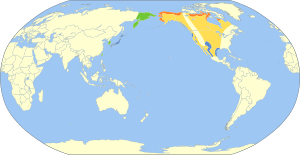Cackling goose facts for kids
Quick facts for kids Cackling goose |
|
|---|---|
 |
|
| Aleutian cackling goose Branta hutchinsii leucopareia |
|
| Conservation status | |
| Scientific classification | |
| Genus: |
Branta
|
| Species: |
hutchinsii
|
| Subspecies | |
|
|
 |
|
| Synonyms | |
|
Branta canadensis hutchinsii |
|
The cackling goose (Branta hutchinsii) is a type of black goose found in North America. It belongs to a group of geese called Branta, which are known for their mostly black feathers. This helps tell them apart from other grey geese.
Contents
What Does a Cackling Goose Look Like?
The cackling goose has a black head and neck with a white "chinstrap" mark. This helps you tell it apart from most other geese. It looks a lot like the larger Canada goose (Branta canadensis). It also looks similar to the barnacle goose (B. leucopsis).
There are up to five different types, called subspecies, of the cackling goose. These subspecies can be different sizes and have small differences in their feathers. Female cackling geese look almost the same as males. They are just a little lighter and have a different voice.
Some cackling geese are hard to tell apart from Canada geese. For a long time, people thought they were the same species. The smallest cackling geese, like B. h. minima, weigh about 1.4 kg (3.1 lb). This is much smaller than any Canada goose. However, the B. h. hutchinsii subspecies can grow up to 3 kg (6.6 lb). This is the same size as some Canada geese.
The barnacle goose is different because it has a black chest. Its body feathers are grey, not brownish like the cackling goose.
Size and Weight
Here are some average measurements for the cackling goose:
- Length: 24.8 to 25.6 inches (63 to 65 cm)
- Weight: 49.3 to 84.0 ounces (1398 to 2380 grams)
- Wingspan: 42.5 to 43.7 inches (108 to 111 cm)
Where Do Cackling Geese Live?
Cackling geese are native to North America. They breed in northern Canada and Alaska. They live in many different tundra areas. Their nests are usually built in high places near water. The geese make a shallow dip in the ground and line it with plants and soft feathers.
Male geese can be very protective of their nesting area. A pair of geese might stay together for their whole lives, which can be up to 20 years. You can often see adult geese leading their young goslings in a line. One parent is at the front, and the other is at the back.
Migration Routes
Like most geese, cackling geese are migratory birds. This means they travel long distances. They spend the winter in most parts of the U.S., and in some areas of western Canada and northern Mexico. When you hear large groups of cackling geese flying in a V-shape overhead, it means spring or fall is coming. In some places, their migration paths have changed. This is because their homes and food sources have changed.
Sometimes, cackling geese fly naturally to western Europe. We know this because of bird bands found on them. These birds are usually from the hutchinsii subspecies. Cackling geese are also found naturally in eastern Siberia, eastern China, and all over Japan.
What Do Cackling Geese Eat?
These birds mainly eat plants. When they feed in water, they put their heads and necks underwater to reach water plants. Sometimes, they tip their bodies forward, like a dabbling duck.
Large groups of cackling geese often eat leftover grains in farm fields. They do this especially during migration or in winter. They also eat some insects, molluscs (like snails), and crustaceans (like small crabs).
Are Cackling Geese Endangered?
In the early 1900s, there were far fewer cackling geese. This was because of too much hunting and losing their homes. But thanks to better hunting laws and programs to save and restore their habitats, their numbers have grown back in most places.
However, some local groups of geese are still decreasing. This is especially true for the minima and leucopareia subspecies. There was also a group of cackling geese that lived near the Komandorski and Kuril Islands. These geese used to spend their winters in Japan. Sadly, they disappeared around 1929 and are now extinct.
How Did the Cackling Goose Get Its Name?
The scientific name for the cackling goose is Branta hutchinsii. The name Branta comes from an old Norse word, Brandgás, which means "burnt (black) goose." The second part of the name, hutchinsii, honors an English surgeon named Thomas Hutchins. He worked for the Hudson's Bay Company.
For a long time, the cackling goose was thought to be the same species as the Canada goose. But in 2004, a group of bird experts in America, the American Ornithologists' Union (AOU), decided they were different. They officially split them into two separate species. Another group of bird experts in Britain, the British Ornithologists' Union (BOU), agreed in 2005.
The AOU then decided which subspecies belonged to the cackling goose. These include:
- Richardson's cackling goose (B. h. hutchinsii)
- Aleutian cackling goose (B. h. leucopareia)
- Small cackling goose (B. h. minima)
- Taverner's cackling goose (B. h. taverneri)
- †Bering cackling goose (B. h. asiatica)—this type is now extinct (around 1929).
It can be tricky to tell the difference between small Canada geese and large cackling geese. This has caused a lot of discussion among scientists.
See also
 In Spanish: Barnacla de Hutchins para niños
In Spanish: Barnacla de Hutchins para niños




